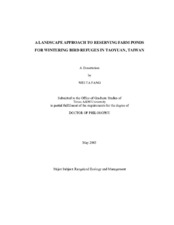| dc.description.abstract | Man-made farm ponds are unique geographic features of the Taoyuan Tableland.
Besides irrigation, they provide refuges for wintering birds. The issue at hand is that
these features are disappearing and bring with it the loss of this refuge function. It is
ecologically significant because one fifth of all the bird species in Taiwan find a home
on these ponds. This study aims at characterizing the diversity of bird species associated
with these ponds whose likelihood of survival was assessed along the gradient of land
development intensities. Such characterization helps establish decision criteria needed
for designating certain ponds for habitat preservation and developing their protection
strategies.
A holistic model was developed by incorporating logistic regression with error
back-propagation into the paradigm of artificial neural networks (ANN). The model
considers pond shape, size, neighboring farmlands, and developed areas in calculating
parameters pertaining to their respective and interactive influences on avian diversity,
among them the Shannon-Wiener diversity index (HÂ’). Results indicate that ponds with
regular shape or the ones with larger size possess a strong positive correlation with HÂ’. Farm ponds adjacent to farmland benefited waterside bird diversity. On the other hand,
urban development was shown to cause the reduction of farmland and pond numbers,
which in turn reduced waterside bird diversity. By running the ANN model with four
neurons, the resulting HÂ’ index shows a good-fit prediction of bird diversity against pond
size, shape, neighboring farmlands, and neighboring developed areas with a correlation
coefficient (r) of 0.72, in contrast to the results from a linear regression model (r < 0.28).
Analysis of historical pond occurrence to the present showed that ponds with
larger size and a long perimeter were less likely to disappear. Smaller (< 0.1 ha) and
more curvilinear ponds had a more drastic rate of disappearance. Based on this finding, a
logistic regression was constructed to predict pond-loss likelihood in the future and to
help identify ponds that should be protected. Overlaying results from ANN and form
logistic regression enabled the creation of pond-diversity maps for these simulated
scenarios of development intensities with respective to pond-loss trends and the
corresponding dynamics of bird diversity. | en |


